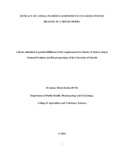| dc.description.abstract | The skin is more predisposed to wounds because of its direct contact with the environment. The
aim of treating wounds is to both hasten their healing and preclude undesirable consequences
that may arise in the process. Plant products for wound healing are cheap and locally available;
they are also purportedly safer than conventional therapies and so they may provide a viable
alternative to expensive conventional wound remedies especially for poor communities in
developing countries. Aspilia pluriseta has been used in a number of traditional medicine
systems to treat lacerations, bruises and burns and it is reputed to aid the healing of such
cutaneous lesions. The aim of this study was to evaluate the efficacy of Aspilia pluriseta in
healing cutaneous wounds and to also test its safety when applied on the skin.
An Aspilia pluriseta ointment was formulated for wound healing studies. Full thickness excision
wounds were created on male adult Swiss albino mice and treated with the ointments in order to
evaluate the influence of the plant material on wound healing. The ointment was applied to two
groups of experimental mice. The first group (n=8) and second group (n=8) were treated with
10% and 20% A. pluriseta based ointment, respectively. A third and fourth group (n=8 each)
were treated with the vehicle ointment alone (Simple Ointment, British Pharmacopeia) and
Silver sulfadiazine (Silverex Cream®) as the negative and positive controls, respectively. All the
mice in the experimental and control groups were treated daily for 21 days. Wound area
measurements were taken every three days and biopsies for histology were taken on the 7th, 14th
and 21st days post-treatment.
The A. pluriseta powder was extracted by cold maceration using methanol to be tested for
antimicrobial activity. The methanol-free extract was dissolved in dimethyl sulfoxide (DMSO)
and distilled water and tested for activity using five bacteria and one fungus by broth macrodilution method. The extract was screened qualitatively for major groups of phytochemical
compounds.
The 20% A. pluriseta based ointment was tested for skin sensitization potential in guinea pigs. It
was applied once a week onto the shaved left flank of three guinea pigs for three weeks
(induction phase). It was then applied onto the right flank of the guinea pigs (challenge phase) 7
days after the last treatment of the induction phase, and the animals observed 24 hours later for
allergic skin reaction. Descriptive statistics were done for quantitative data and one-way analysis
of variance was used to compare the means of responses between treatment groups. P-values less
than 0.05 were considered statistically significant.
The A. pluriseta ointment preparation enhanced wound healing to an extent that was comparable
to that of the standard drug (Silverex Cream®) in terms of epithelialization time (15.5±1.118 days
compared to 16.5±0.616 days for the 20% A. pluriseta ointment and standard drug, respectively)
and wound contraction (28.17±3.725 and 57.75±6.178 percent wound area reduction on the 6th
and 9th days post-wounding, respectively for the 20% A. pluriseta powder ointment compared to
14.98±7.194 and 36.37±4.871 for the standard drug on the same days). Histopathology revealed
that the plant material accelerated remodeling in the wounded tissue and increased the amount of
collagen in the scar compared to the negative control. The extract had marginal antimicrobial
activity against Staphylococcus aureus, Bacillus subtilis and Streptococcus agalactiae with a
Minimum Inhibitory Concentration (MIC) of between 50 mg/ml and 200 mg/ml and Minimum
Bactericidal Concentration (MBC) ranging from 100 to 800 mg/ml. The extract contained
triterpeniods, tannins, glycosides, saponins and phenols. The 20% A. pluriseta ointment induced
moderate sensitization in guinea pigs. | en_US |

